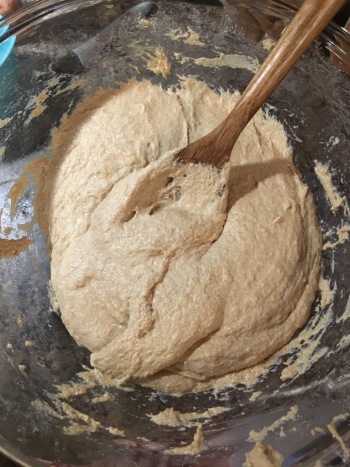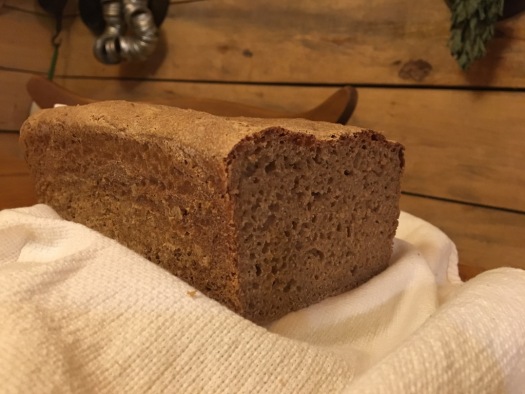Einkorn Sourdough Bread (THM-E)
I fell in love with sourdough this year. I made my own starter from the usual all-purpose flour and loved the results.
Years ago, I made sourdough from rye and spelt according to the recipe in The Trim Healthy Mama Cookbook. But my husband isn’t crazy about rye.
(This post includes Amazon affiliate links and THM affiliate links. If you click and purchase, I can receive commission at no extra cost to you!)
So I recently found some whole wheat einkorn flour! I was so pumped to get this stuff. Einkorn is the only non-hybridized wheat. It is an ancient grain and it is still true to the original wheat that was used a thousand years ago! That is cool!
It’s also higher in protein, higher in fiber, and lower in gluten than modern wheat flour.
Fermenting, or souring, the wheat takes the benefits even further. It adds all sorts of good bacteria and helps to naturally preserve the bread.
It makes it taste wonderfully delicious, too!
Here’s my process to get started:
A week or two before you get to make the bread, you have to make your starter. This is not a hard process at all…you just have to be patient.
To begin the sourdough starter, just have a clean quart jar. Put ½ cup einkorn whole wheat into the jar. Add ¼ cup non-chlorinated, room temperature water. Stir it up, and put a coffee filter on top, and secure with a rubber band. You can use a towel or whatever you have to cover the jar. Just let it breathe.
Let the jar sit in a warm spot for a whole day. I put mine on my oven, so it catches warmness from cooking.
The next day, hopefully the flour mixture is kind of bubbly looking. Go ahead and add another ½ cup of einkorn, and another ¼ cup water. Stir it all together. Secure the coffee filter with the rubber band and let it sit for another day.
By now it should be noticeably bubbly. Not bubbling like boiling water, but you should see little air bubbles on the side of the jar. If you keep an eye on it, the bubbles will change and move around. If you do not have bubblies, it may not be souring properly. I have had success with all my starters, so if the mixture just looks…flat…you may want to contact the Pinterest or Google sourdough experts to see what to do.
You’ll let the sourdough sit for another day.
The next day, this will be the third day, you will discard some of the starter. This means you will pour some out. I’m not fussy about this part, I will just pour a bit out into another clean jar. This will be my discard jar that goes in the fridge. (Use it for pancakes, waffles, or for fermented oatmeal.)
After you’ve poured some out (remember, don’t pour much, no more than half!), feed ½ cup flour and ¼ cup of water again. Put the top on again and let it sit for another day.
The next day, repeat the step above. (Discard, feed…let it sit another day.)
Do this until you notice your starter growing after you feed it, sometimes it will double in size! When you have at least 2 cups, preferably more, starter—it’s time to make bread! You’ll also want your starter to be fairly “mature”, so be sure it’s at least a week or two old. It’ll rise better when it is more mature.
Also, if you want more starter quicker…add more flour and water. I used ½ c flour to ¼ c water, but you could increase the ratios to whatever suits you.
The Recipe
Einkorn Sourdough Bread (makes one bread pan)
2 cups mature and active einkorn sourdough starter
1 cup water
3 cups whole wheat einkorn flour
½ tbsp mineral salt
Combine all the ingredients in a large bowl, incorporating the three cups of flour one cup at a time. Stir it all together. The dough will be sticky. It’s not too runny, but it’s not hard enough to knead.
Since it is a loose dough, just take a wooden spoon and work the dough in your bowl. Work it around for several minutes. I didn’t time myself, but you want to put in a good ten minutes of “kneading”. Just take the spoon at the top of the bowl, and pull the dough down, and rotate from there.
After the dough has been worked, it’ll still be sticky, but will not be sticking heavily to the bowl.

Grease a bread pan, and pour the dough into it.
Let it rise in a warm place for 4 hours or more. It must take this long to rise because I’m only using natural yeast from the starter, no added yeast or sugar. I turned on my oven light and let it rise in the oven for four hours. Just let it rise until the top is coming up over the bread pan. Not too much or it will fall! Rising time will vary depending on the temperature of your house. That’s why I put it in the oven in a warm environment.
Now, preheat the oven to 400 degrees. Set a pan of water on the bottom rack for a steam effect. (I learned that trick from the recipe for Artisan Sourdough Bread in Trim Healthy Mama Cookbook.)
Put the bread back into the heated oven, and cook at 400 for about 10 minutes. Then decrease the time to 350 degrees. It will need to bake for another hour at least.
(I’m sorry I am not good at giving exact times, because frankly, baking with sourdough is a little more unpredictable. Someone’s sourdough may be thicker just because the starter was thicker, so the bread may take longer to rise, or cook, ect. So just keep an eye on the bread, and after an hour, check it with a knife to see if the center is done. By an hour, it should be good to go…if not, let it cook for another 30 minutes.)
I let the bread cool in the pan, then I turned it out onto the counter.
Let it cool completely before storing. I use a plastic twisty-tie baggy, but you can use your favorite method of storing bread.
**This was my first attempt at Einkorn sourdough, and I was pleasantly surprised and pleased with the outcome! I was afraid I’d end up with a brick…but it was just like the other sourdough I had made before in that it had a harder crust. The color is obviously darker, and the inside of the bread was perfectly moist and delicious.

Einkorn sourdough bread rocked our homemade bread world, and I don’t know if I can go back to white bread! Plus, it’s on the THM plan as an E bread, so I feel good about these pure healthy carbs!
Need something from the THM store? I’d be honored if you shopped through my affiliate link!
Edited and updated:
See this post on Sourdough 101 for more info on getting started with your own sourdough creations!



Pursuing Authenticity (or Why I Bake Bread) – amy c. grimes (a quiet nurturing of creativity and community)
[…] the original, ancient, untampered-with grain. I found out about einkorn when my friend Rachel from J&R Farms posted about it on her blog. She had me at “the only non-hybridized wheat”, because, as I said, […]
Kimberly D Morais
Is this still on plan if we do not ferment it the full 7 hours after mixing?
jrfarms
Hi! Yes, it would still be on plan, but the sourdough-ness of the bread needs the full fermentation time. At least from this particular recipe. Baking with einkorn is a little trickier, it is quite dense. I had to let it rise for a while to get the desired height.
But by itself, yes, einkorn is an on plan flour. (It’s an E) Here’s an excerpt from a THM article about Baking with Whole Grain Flours:
Ancient Wheat Flours (Einkorn, Spelt, Kamut, Freekah, and Emmer):
These flours have lower amounts of gluten than modern wheat and are often better
digested which sometimes (but not always) allows for gluten sensitive people to be able
to use them. They work beautifully for breads and other baked goods. They are chock
full of B vitamins and contain higher protein levels and greater micronutrients such
as polyphenols and minerals when compared to modern wheat. They are best sprouted
or soured to lower blood sugar rise.
Sourdough 101 – J&R Farms
[…] Einkorn Sourdough recipe here […]